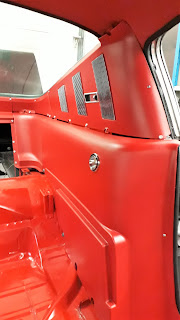Bolting continued with bumbers, headlights, turn signal lights, turn signal switch (which had to be repaired first) sun visors, rear view mirror, reconditioned instrument cluster, emblems, switches, knobs, radio, dash pad (which required a lot of fitting and trimming), horns, windshield wipers, speedometer wire,...
 |
| The odometer has only 00000 miles on it now |
The battery was relocated in the trunk with safety main power switch. All the electricity was tested and found working well. I bought some Moroso aluminium 3/8" fuel line and bent a one-piece line. It follows the original route over the rear axle, then goes along the subframe connectors, through the torque-box and finally through into the engine compartment after the front frame rail.
 |
| Gas tank installed |
 |
| Battery and main switch relocated |
 |
| 3/8" one-piece aluminium fuel line |
Back inside the car the carpets and seats were installed and the black steering wheel was repaired and paint red. This car used to have a deluxe wheel but so many parts were missing that I decided to start with the standard wheel for which I had all the necessary parts for horn.
 |
| Carpets |
 |
| Seats |
 |
| Steering wheel |
Before towing her back to storage for the summer (as I cannot continue before I get my motor back from the machinist), Snowback was pushed out and given a first tender hand wash after the paint job.
To be continued...















































